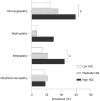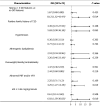Hemoglobin glycation index among adults with type 1 diabetes: Association with double diabetes features
- PMID: 40236850
- PMCID: PMC11947909
- DOI: 10.4239/wjd.v16.i4.100917
Hemoglobin glycation index among adults with type 1 diabetes: Association with double diabetes features
Abstract
Background: The hemoglobin glycation index (HGI) represents the discrepancy between the glucose management indicator (GMI) based on mean blood glucose levels and laboratory values of glycated hemoglobin (HbA1c). The HGI is a promising indicator for identifying individuals with excessive glycosylation, facilitating personalized evaluation and prediction of diabetic complications. However, the factors influencing the HGI in patients with type 1 diabetes (T1D) remain unclear. Autoimmune destruction of pancreatic β cells is central in T1D pathogenesis, yet insulin resistance can also be a feature of patients with T1D and their coexistence is called "double diabetes" (DD). However, knowledge regarding the relationship between DD features and the HGI in T1D is limited.
Aim: To assess the association between the HGI and DD features in adults with T1D.
Methods: A total of 83 patients with T1D were recruited for this cross-sectional study. Laboratory HbA1c and GMI from continuous glucose monitoring data were collected to calculate the HGI. DD features included a family history of type 2 diabetes, overweight/obesity/central adiposity, hypertension, atherogenic dyslipidemia, an abnormal percentage of body fat (PBF) and/or visceral fat area (VFA) and decreased estimated insulin sensitivity. Skin autofluorescence of advanced glycation end products (SAF-AGEs), diabetic complications, and DD features were assessed, and their association with the HGI was analyzed.
Results: A discrepancy was observed between HbA1c and GMI among patients with T1D and DD. A higher HGI was associated with an increased number of SAF-AGEs and a higher prevalence of diabetic microangiopathy (P = 0.030), particularly retinopathy (P = 0.031). Patients with three or more DD features exhibited an eight-fold increased risk of having a high HGI, compared with those without DD features (adjusted odds ratio = 8.12; 95% confidence interval: 1.52-43.47). Specifically, an elevated PBF and/or VFA and decreased estimated insulin sensitivity were associated with high HGI. Regression analysis identified estimated insulin sensitivity and VFA as factors independently associated with HGI.
Conclusion: In patients with T1D, DD features are associated with a higher HGI, which represents a trend toward excessive glycosylation and is associated with a higher prevalence of chronic diabetic complications.
Keywords: Advanced glycation end products; Diabetic complications; Double diabetes; Hemoglobin glycation index; Insulin resistance; Type 1 diabetes.
©The Author(s) 2025. Published by Baishideng Publishing Group Inc. All rights reserved.
Conflict of interest statement
Conflict-of-interest statement: The authors declare that they have no conflict of interest.
Figures



Similar articles
-
Factors associated with hemoglobin glycation index in adults with type 1 diabetes mellitus: The FGM-Japan study.J Diabetes Investig. 2023 Apr;14(4):582-590. doi: 10.1111/jdi.13973. Epub 2023 Feb 14. J Diabetes Investig. 2023. PMID: 36789495 Free PMC article.
-
Correlation Between Hemoglobin Glycation Index Measured by Continuous Glucose Monitoring With Complications in Type 1 Diabetes.Endocr Pract. 2023 Mar;29(3):162-167. doi: 10.1016/j.eprac.2023.01.001. Epub 2023 Jan 7. Endocr Pract. 2023. PMID: 36627022
-
Concordance the hemoglobin glycation index with glycation gap using glycated albumin in patients with type 2 diabetes.J Diabetes Complications. 2017 Jul;31(7):1127-1131. doi: 10.1016/j.jdiacomp.2017.04.015. Epub 2017 Apr 18. J Diabetes Complications. 2017. PMID: 28487124
-
Association Between Hemoglobin Glycation Index and Risk of Cardiovascular Disease and All Cause Mortality in Type 2 Diabetic Patients: A Meta-Analysis.Front Cardiovasc Med. 2021 May 28;8:690689. doi: 10.3389/fcvm.2021.690689. eCollection 2021. Front Cardiovasc Med. 2021. PMID: 34124211 Free PMC article.
-
Prognostic factors for the development and progression of proliferative diabetic retinopathy in people with diabetic retinopathy.Cochrane Database Syst Rev. 2023 Feb 22;2(2):CD013775. doi: 10.1002/14651858.CD013775.pub2. Cochrane Database Syst Rev. 2023. PMID: 36815723 Free PMC article. Review.
Cited by
-
The Association Between the Hemoglobin Glycation Index and Cardiometabolic Diseases: A Mini-Review.J Clin Hypertens (Greenwich). 2025 Jul;27(7):e70092. doi: 10.1111/jch.70092. J Clin Hypertens (Greenwich). 2025. PMID: 40662995 Free PMC article. Review.
References
-
- Holt RIG, DeVries JH, Hess-Fischl A, Hirsch IB, Kirkman MS, Klupa T, Ludwig B, Nørgaard K, Pettus J, Renard E, Skyler JS, Snoek FJ, Weinstock RS, Peters AL. The management of type 1 diabetes in adults. A consensus report by the American Diabetes Association (ADA) and the European Association for the Study of Diabetes (EASD) Diabetologia. 2021;64:2609–2652. - PMC - PubMed
-
- Rezende PC, Hlatky MA, Hueb W, Garcia RMR, da Silva Selistre L, Lima EG, Garzillo CL, Scudeler TL, Boros GAB, Ribas FF, Serrano CV Jr, Ramires JAF, Kalil Filho R. Association of Longitudinal Values of Glycated Hemoglobin With Cardiovascular Events in Patients With Type 2 Diabetes and Multivessel Coronary Artery Disease. JAMA Netw Open. 2020;3:e1919666. - PMC - PubMed
-
- Herman WH, Ma Y, Uwaifo G, Haffner S, Kahn SE, Horton ES, Lachin JM, Montez MG, Brenneman T, Barrett-Connor E Diabetes Prevention Program Research Group. Differences in A1C by race and ethnicity among patients with impaired glucose tolerance in the Diabetes Prevention Program. Diabetes Care. 2007;30:2453–2457. - PMC - PubMed
-
- Hempe JM, Gomez R, McCarter RJ Jr, Chalew SA. High and low hemoglobin glycation phenotypes in type 1 diabetes: a challenge for interpretation of glycemic control. J Diabetes Complications. 2002;16:313–320. - PubMed
LinkOut - more resources
Full Text Sources

